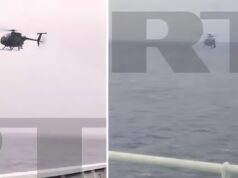After recently completing the successful Strike Warrior exercise and returning to Portsmouth on October 30, HMS Prince of Wales is preparing to depart again tonight, reflecting the Royal Navy’s commitment to ongoing operational readiness.
According to today’s scheduled shipping movements from KHM Portsmouth, HMS Prince of Wales will leave Portsmouth at 19:30 tonight, accompanied by an escort of tugs, including “Tempest,” “Bountiful,” “Indulgent,” and “Independent,” among others.
The main channel will be closed to other inbound and outbound vessels from 18:40 to 20:40, ensuring a clear path for the carrier’s exit. The small boat channel will also be restricted starting at 20:00.
This deployment follows HMS Prince of Wales’ recent role in Strike Warrior, a major multinational exercise held off the Scottish coast. The exercise was a significant step in preparing for the UK Carrier Strike Group 2025 deployment.
Portsmouth locals and maritime enthusiasts will have a chance to witness the impressive vessel as she sails out tonight.
The ship and her sister
The Queen Elizabeth-class aircraft carriers are the largest and most advanced warships in the Royal Navy, designed to serve as the primary components of the UK’s Carrier Strike Group. This class includes two vessels: HMS Queen Elizabeth, commissioned in December 2017, and HMS Prince of Wales, commissioned in December 2019. Built by the Aircraft Carrier Alliance, these carriers were developed at a total cost of approximately £7.6 billion. They replace the earlier Invincible-class carriers and are built to support a variety of maritime operations.
Each Queen Elizabeth-class carrier has a displacement of 65,000 tonnes and a length of 284 metres. Their propulsion is provided by integrated electric systems combining Rolls-Royce Marine Trent MT30 gas turbines with Wärtsilä diesel engines, producing a total power of 158,800 horsepower. These vessels are capable of speeds over 25 knots and can travel up to 10,000 nautical miles on a single mission. They have berths to accommodate up to 1,600 personnel, including crew and air support units.
The carriers can house an air wing of up to 40 aircraft, including F-35B Lightning II jets and Merlin helicopters for roles such as anti-submarine warfare and airborne early warning. The flight deck, equipped with a 12º ski jump, is optimised for short takeoff and vertical landing (STOVL) operations, enabling the launch and recovery of F-35B aircraft. The hangar deck provides additional space for the maintenance and storage of these aircraft, with dimensions of 155 m x 34 m x 7 m.
For defence and situational awareness, each carrier is outfitted with a Phalanx Close-In Weapons System (CIWS), 30 mm DS30M Mk2 guns, and heavy machine guns. The radar and sensor systems include the S1850M long-range radar and Type 997 Artisan 3D radar, providing extensive tracking and detection capabilities to support the carrier’s operations.
At the UK Defence Journal, we aim to deliver accurate and timely news on defence matters. We rely on the support of readers like you to maintain our independence and high-quality journalism. Please consider making a one-off donation to help us continue our work. Click here to donate. Thank you for your support!














Interesting
Correction no DS30 mounts, or any point defence missile system.
I wonder if she will meet up with QE? Iron Duke must be close by to offer at least one escort and to practice operations?
They will have a very clear operational program.
Oh yeah I appreciate that all operations are worked out weeks and months in advance.
Has there been any news on what QE has been up to since she left Portsmouth?
All I know is she has 4 Wildcats on-board.
Thanks for the info Robert 👍
Probably had to return to port to re-victual as there are no RFA Store Ships available to store her at sea!!!
Aha, that’s the futuristic ‘lasy band wound up, gangway ya barstewards, coming through. FLY NAVY 😊🕳️.